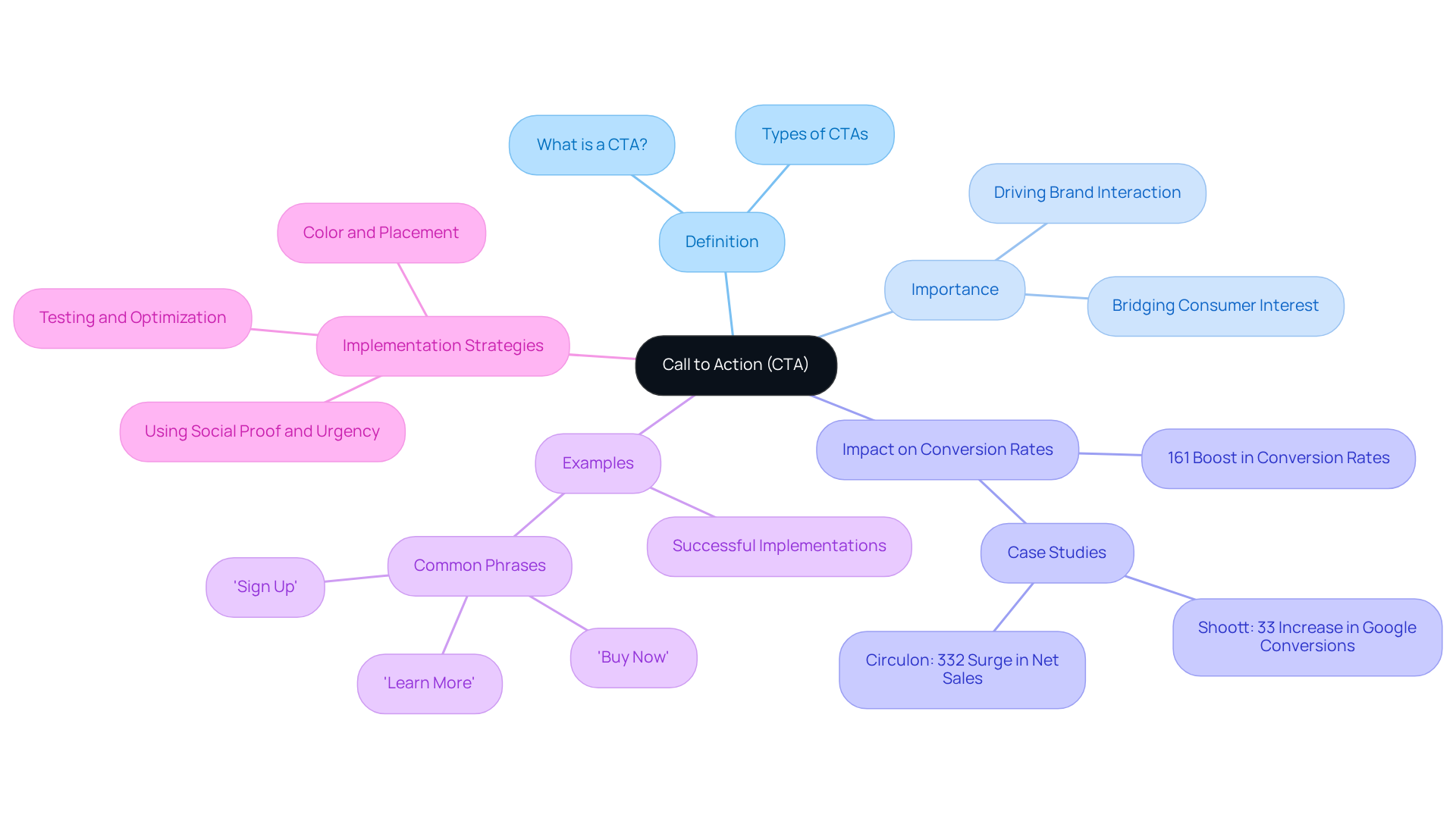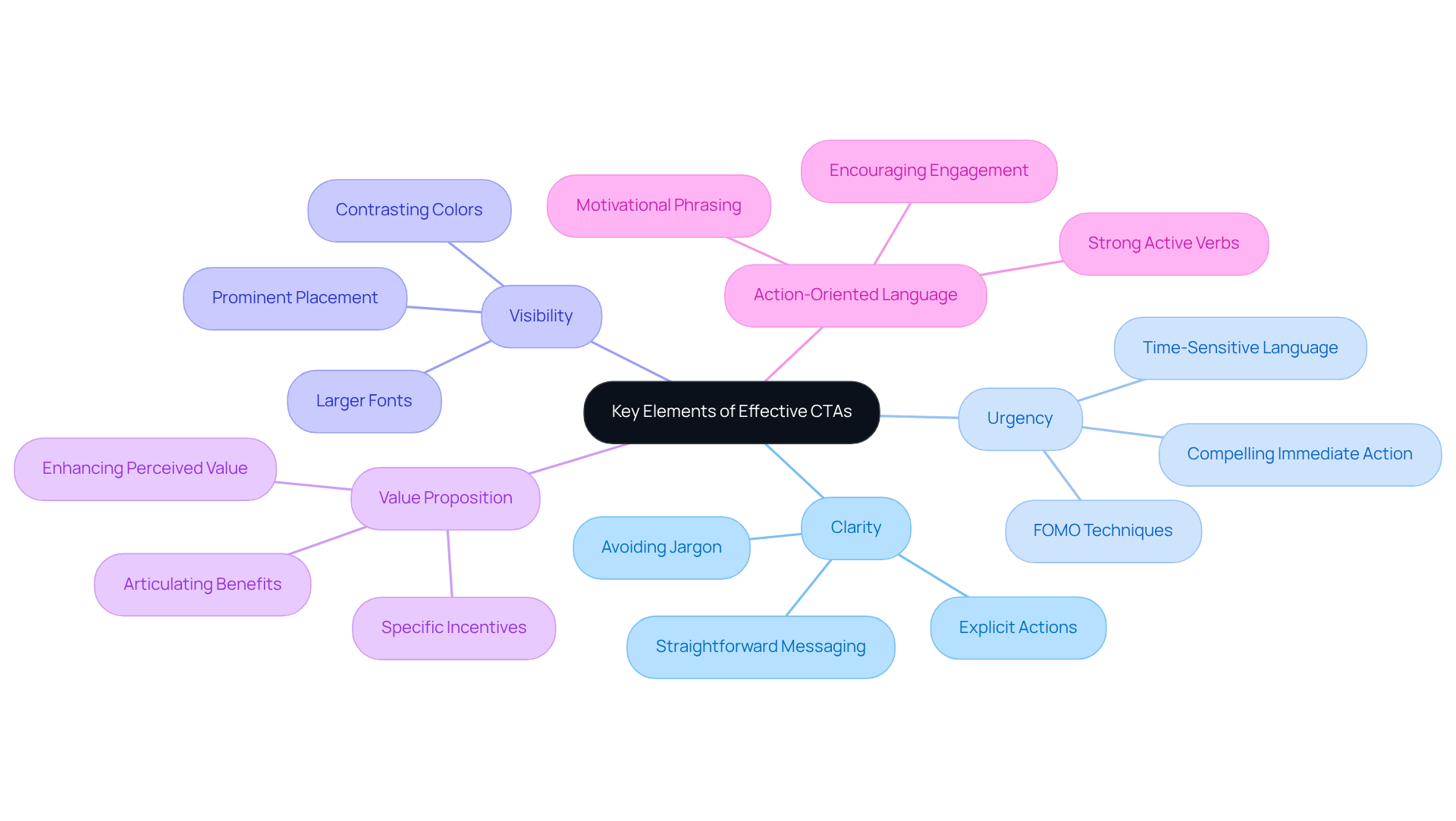
Overview
Creating effective calls to action (CTAs) is crucial for boosting conversions in direct-to-consumer (DTC) brands. Great CTAs not only guide consumer behavior but also enhance profitability. Evidence shows that strategic implementation of CTAs can significantly elevate conversion rates and overall success metrics.
To truly understand the impact of CTAs, consider this: brands that invest in well-crafted CTAs see a marked improvement in their conversion rates. This isn’t just a theory; it’s backed by data and case studies that illustrate the power of a compelling CTA. For instance, brands that utilize clear, action-oriented language in their CTAs often report higher engagement levels and increased sales.
The takeaway is clear: CTAs are not merely an afterthought; they are a fundamental component of a successful marketing strategy. By focusing on creating CTAs that resonate with your audience, you can drive consumer action and ultimately boost your bottom line. Remember, the right CTA can make all the difference in guiding potential customers toward making a purchase.
Introduction
Unlocking the potential of direct-to-consumer (DTC) brands hinges on one critical element: the call to action (CTA). These succinct prompts not only guide consumers toward making decisions but can dramatically elevate conversion rates. In fact, some studies indicate an increase of up to 161%. As brands strive to capture attention in a crowded marketplace, understanding how to craft compelling CTAs becomes essential.
What makes a CTA not just good, but great? This article delves into the key components and psychological strategies that can transform a simple prompt into a powerful tool for driving engagement and profitability. By mastering the art of the CTA, brands can not only enhance their visibility but also significantly boost their bottom line.
Define the Call to Action: Importance and Impact
A call to action (CTA) serves as a crucial prompt that encourages users to take specific actions, such as 'Buy Now', 'Sign Up', or 'Learn More'. The importance of great calls to action cannot be overstated; they bridge the gap between consumer interest and successful outcomes. Great calls to action significantly influence success metrics, guiding potential clients through the sales process and fostering brand interaction. Research shows that great calls to action can boost conversion rates by as much as 161%.
At Parah Group, we leverage our expertise in Conversion Rate Optimization (CRO) to craft CTAs that resonate with your audience while driving sustainable growth and profitability. Our compelling case studies demonstrate how strategic CTA implementation has yielded remarkable results for DTC brands, enhancing their profitability without necessitating increased advertising costs.
Thus, defining and implementing great calls to action is an essential step for DTC brands seeking to improve profitability and achieve measurable success.

Identify Key Elements of Effective CTAs
Great calls to action are essential for boosting conversion rates and showcasing the long-term benefits of Conversion Rate Optimization (CRO). Here are the critical elements that can elevate your marketing efforts:
-
Clarity: A clear message is paramount. It should be straightforward and easily understood, avoiding jargon. When the desired action is explicit, clarity directly correlates with higher conversion rates. This seamless user experience is fundamental to effective CRO strategies.
-
Urgency: Incorporating time-sensitive language, such as 'Limited Time Offer' or 'Act Now', creates a sense of urgency that compels immediate action. Research indicates that great calls to action driven by urgency lead to higher engagement and quicker responses from prospective customers, enhancing the overall efficiency of your marketing initiatives.
-
Visibility: CTAs must be visually prominent on the page. Achieving this can involve using contrasting colors, larger fonts, or strategic placement to ensure they capture attention effectively. Studies reveal that CTAs designed with bright, contrasting colors achieve higher click-through rates compared to standard hyperlinks, making them a crucial element in your growth strategy.
-
Value Proposition: Clearly articulate the benefits of taking action. Instead of a generic 'Sign Up', opt for 'Sign Up for Exclusive Discounts' to convey the value individuals will receive, making the action more appealing. This not only informs the individual but also enhances the perceived value of the action, a key aspect of effective CRO strategies.
-
Action-Oriented Language: Use strong, active verbs that inspire action, such as 'Get', 'Join', or 'Discover'. This type of language motivates users and enhances the overall effectiveness of the CTA.
By merging these components and incorporating thorough evaluation into your marketing strategies, brands can craft great calls to action that resonate with their audience, ultimately leading to increased success and greater profitability.

Leverage Consumer Psychology to Enhance CTA Effectiveness
To enhance the effectiveness of CTAs, brands must leverage principles of consumer psychology, as demonstrated by successful strategies employed by Parah Group:
-
Emotional Triggers: Language that evokes strong emotions is essential. Phrases like 'Join the Community' or 'Experience the Joy of Savings' foster a deeper connection with the audience, encouraging engagement. Research indicates that emotional appeals can enhance response rates by as much as 20%. For instance, a $30M clothing brand saw a substantial increase in sales after introducing emotionally appealing CTAs.
-
Social Proof: Incorporating testimonials or user counts builds trust and credibility. Using phrases such as 'Join 10,000+ Happy Customers' not only showcases popularity but also reassures potential customers of your offering's value. Studies reveal that including user-generated content can boost CTA effectiveness by 50%. Parah Group's case studies show that brands utilizing social proof experienced a significant rise in success metrics, with one client noting a 35% boost in sales after emphasizing customer testimonials.
-
Scarcity and Urgency: Highlighting limited availability or time-sensitive offers prompts immediate action. Phrases like 'Only 3 Left!' or 'Sale Ends Tonight!' create a sense of urgency that can significantly drive conversions. A/B testing has shown that urgency-driven calls to action can result in a 30% boost in click-through metrics, as indicated by tactics used for various DTC brands.
-
Personalization: Tailoring calls to action to specific audience segments is crucial. Customized messages, such as addressing individuals by name or referencing their past interactions, can significantly improve engagement and success levels. According to Trevin Shirey, VP of Marketing at WebFX, customized calls to action can enhance conversion rates by as much as 40%. Parah Group's strategy involves tailoring calls to action based on user behavior, resulting in enhanced outcomes, with one brand noting a 25% rise in engagement after adopting personalized calls to action.
-
Visual Design Elements: The design of call-to-action buttons is equally important. Utilizing high-contrast colors and appropriate button sizes enhances visibility and encourages clicks. For example, a study found that buttons colored in warm tones like orange can increase engagement by 20%. Parah Group emphasizes the significance of design in their CRO strategies, ensuring that calls to action are not only compelling in text but also visually appealing.
By comprehending and implementing these psychological principles, while avoiding common pitfalls like overemphasizing urgency or neglecting design, DTC brands can create great calls to action that not only attract attention but also motivate individuals to take action, ultimately driving revenue growth and boosting profitability.

Examine Real-World Examples of High-Performing CTAs
Examine Real-World Examples of High-Performing CTAs
-
Dropbox: Their 'Get Started for Free' CTA effectively provides immediate value without obligation, appealing to individuals' desire to try before they buy. This strategy not only reduces the barrier to entry but also promotes trust among participants.
-
Spotify: The 'Get Spotify Free' CTA utilizes the appeal of free trials, attracting individuals to participate without financial risk. This approach capitalizes on the psychological appeal of experiencing a service before making a financial commitment.
-
Amazon: The 'Add to Cart' button is strategically positioned and visually prominent, facilitating easy action for customers. This simplicity in design ensures that individuals can navigate the purchasing process effortlessly, enhancing overall conversion rates.
-
Airbnb: Their 'Start Your Search' CTA is simple yet impactful, directing individuals straight to the next stage in the booking process. This clarity helps streamline user experience, encouraging potential customers to engage with the platform.
By examining these examples, DTC brands can gain valuable insights into the design and implementation of great calls to action. Adjusting these strategies to suit their unique offerings can ultimately enhance success. Furthermore, Parah Group's case studies demonstrate how strategic CTA implementations can lead to substantial improvements in success metrics. For instance, a $30M clothing brand experienced a 35% rise in engagement levels after enhancing their homepage to emphasize social proof and testimonials. Similarly, a $15M cleaning product brand improved their average order value (AOV) by 80% through effective bundling strategies and clear value propositions. These results not only showcase the effectiveness of great calls to action but also highlight how improved conversion rates can significantly enhance profitability for DTC brands.

Conclusion
Crafting effective calls to action is not just important; it’s essential for DTC brands looking to optimize conversion rates and drive profitability. By grasping and applying the principles of impactful CTAs, brands can turn consumer interest into tangible results. These prompts are more than mere words; they serve as strategic tools that guide potential customers through the sales funnel, ultimately enhancing brand engagement and financial success.
Key elements such as:
- Clarity
- Urgency
- Visibility
- A compelling value proposition
are critical components of successful CTAs. Moreover, integrating consumer psychology—leveraging emotional triggers, social proof, and personalization—further amplifies the effectiveness of these calls to action. Real-world examples from leading brands demonstrate how thoughtfully designed CTAs can lead to significant increases in engagement and conversion rates, validating the strategies discussed.
In conclusion, DTC brands must prioritize the development of exceptional calls to action within their marketing strategies. By employing the insights and best practices outlined, brands can enhance customer interactions and drive sustained growth. Embracing the power of well-crafted CTAs is a vital step toward achieving measurable success in the competitive landscape of digital marketing.
Frequently Asked Questions
What is a call to action (CTA)?
A call to action (CTA) is a prompt that encourages users to take specific actions, such as 'Buy Now', 'Sign Up', or 'Learn More'.
Why are calls to action important?
Calls to action are important because they bridge the gap between consumer interest and successful outcomes, significantly influencing success metrics and guiding potential clients through the sales process.
How much can great calls to action boost conversion rates?
Research shows that great calls to action can boost conversion rates by as much as 161%.
How does Parah Group utilize CTAs?
Parah Group leverages its expertise in Conversion Rate Optimization (CRO) to craft CTAs that resonate with audiences and drive sustainable growth and profitability.
What evidence is there of the effectiveness of strategic CTA implementation?
Compelling case studies at Parah Group demonstrate that strategic CTA implementation has yielded remarkable results for DTC brands, enhancing profitability without the need for increased advertising costs.
What should DTC brands focus on to improve profitability?
DTC brands should focus on defining and implementing great calls to action as an essential step to improve profitability and achieve measurable success.
FAQs











